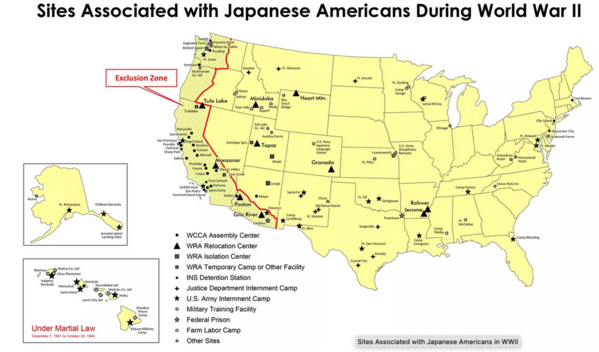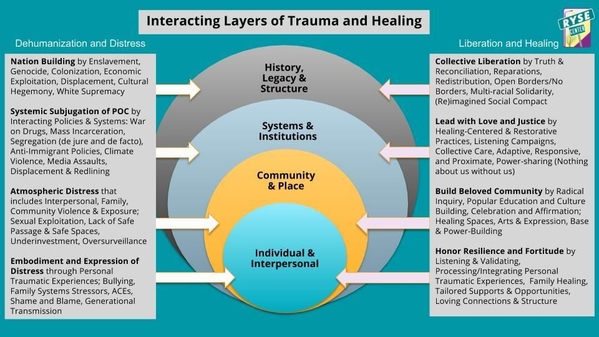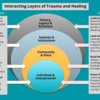On January 20, 2022, PACEs Connection hosted the fourth event in our Historical Trauma in America series. The event was facilitated by PACEs Connection staff members Dana Brown (organizational liaison), Donielle Prince (director of state initiatives), John Dovales Flores (California central valley, central coast community facilitator), and Natalie Audage (family and community resources lead). The event featured Dr. Valerie Ooka Pang, a Japanese American professor and author from San Diego State University who grew up in Washington state.
Click here to download the slide deck from this presentation. Then click “download file.”
Click here to download resources from this presentation. Then click “download file.”
The series examines the impact of intergenerational trauma on the health and well-being of individuals today. Historical trauma—another term for intergenerational trauma—is defined by Dr. Maria Yellow Horse Brave Heart as multigenerational trauma experienced by a specific cultural group resulting in “a cumulative emotional and psychological wounding over the lifespan and across generations, emanating from massive group trauma." As recent advances in the science of positive and adverse childhood experiences (PACEs) continue to show the profound impact of historical trauma on society today, PACEs Connection launched this series to educate and empower people to take action to mitigate its adverse impact and promote resilience in their regions.
Please read about events focused on the South, Midwest, and Northeast (coming soon).
Please click here to register for future Historical Trauma in America series events on the American Southwest (3/17/22) and the State of Hawaii & the U.S. Territories (5/19/22).
Rafael Maravilla (PACEs Connection Network Manager) began the American Northwest session with the Indigenous Prayer of the Four Directions. Audage followed with a brief overview of PACEs Connection and adverse childhood experiences (ACEs) and a review of introductory material from other sessions in the series, including the concepts of collective trauma, intergenerational transmission of trauma, and historical trauma. Particular attention was given to the RYSE Center’s infographic on Interacting Layers of Trauma and Healing, which details examples of "Dehumanization and Distress" as well as "Liberation and Healing" at four different layers of society: "individual and interpersonal"; "community and place"; "systems and institutions"; and "history, legacy, and structure."
The rest of the session focused on the "Dehumanization and Distress" side of this infographic, drawing parallels between the ways that people of color in the Northwest have been dehumanized and subjected to white supremacy. Presenters used terms from this framework to organize the traumatic historical events and their current-day impacts.
Beginning with the Indigenous peoples of the American Northwest, Brown reflected on the decades-long research of genocidal war against our nation’s Indigenous nations. Examples include the smallpox epidemic that annihilated the Haida Tribe; the extinction of the Yahi Tribe when Ishi died on August 29, 1911; the relevance today with the Dakota Access Pipeline at Standing Rock, North Dakota, against the Sioux Water Protectors; and how COVID-19 has decimated Indigenous people throughout the American Northwest and U.S. During her presentation, Brown shared the following quote from Dr. Brave Heart about the process of moving forward from historical grief: “First is confronting the historical trauma. Second is understanding the trauma. Third is releasing the pain of historical trauma. Fourth is transcending the trauma.”
Prince followed with information about the African American experience in the Northwest, beginning with the Great Migration, in which millions of African Americans fled the South and migrated to other parts of the country, including California, Oregon, and Washington. Prince shared the racially restrictive language from the covenants in current house deeds in East Sacramento, Davis, and Seattle, as well as Exclusion Laws in Oregon, as examples of how displacement and segregation played out in the Northwest.
Dovales Flores focused on economic exploitation, displacement, anti-immigrant policies, and mass incarceration experienced by Asian-American and Pacific Islander communities in the Northwest. He drew from examples such as the Gold Rush, the building of the Transcontinental Railroad, and the Chinese Exclusion Act of 1882 in the 19th century and Anti-Filipino Riots, Executive Order 9066 (which authorized the incarceration of Japanese Americans during World War II), and SARs/COVID discrimination in the 20th and 21st centuries.
Guest speaker Dr. Valerie Ooka Pang provided a moving presentation entitled “Born in the USA: Japanese American Incarceration and Issues of Equity.” She described how members of her family had been subjected to mass incarceration in internment prisons during World War II. She showed pictures of the dehumanizing conditions in the prisons, including public communal toilets and horse stalls where people were forced to live. She shared that her family also struggled to find a place to live after the war and that family members were forced to be separated as a result. After providing examples of current anti-Asian discrimination, she called on participants to find out more about all types of oppression and to stand up and speak out against them.

[For information about the National Park Service map, go to: http://www.nps.gov/articles/ja...nment-archeology.htm]
Audage closed the presentation with current data on hate crimes and health disparities by race, highlighting the connection between trauma and health.
During the discussion portion of the webinar, Prince asked the participants to share what they had learned during the presentation.
The following is a sampling of what attendees shared:
- Chancellor S. “Before today, I didn't know the extent of the dehumanization in the internment jails. I also didn't know that it hit so close to home (Greater Seattle Area Resident).”
- Kristi B. “Learned about the extreme racism Blacks were met with in Oregon and Washington - thank you for sharing this, I will research more.”
- Greinilda A. “I can see how our past is extremely significant to our present. This was amazing information. I understand better why there is so much hate at this time. It is generational.”
- Jacob D. “The ability to create an equitable society is dependent upon the ability to be honest and open about what has occurred throughout history. We have to share that understanding in order to grow together as a communal society. We have to examine the legislative system that tends to reinforce institutional/structural racism through national values mired in white privilege.”
- Susan B. “I learned so much (that I should have previously learned), it is hard to pinpoint one thing. Thank you for this presentation and the perspectives of the speakers. This is important information. Thanks to Dr. Pang for sharing her family's experiences.”
- Carey S. “The way laws were used to demonize and marginalize people. We need to always remember this. And realize that not having voting rights protected sets us up for more of the same.”
Attendees provided the following recommendations for further learning:
Jacob Davis: Movies on Indigenous peoples worth watching:
- Indian Horse (boarding schools)
- Blood Memory (Indian Child Welfare)
- Dawnland (Maine Truth and Reconciliation Commission)
- Gather (Food Sovereignty)
- Reservation Dogs (Contemporary TV Show)
- Rutherford Falls (Contemporary TV Show)
- Basketball or Nothing (Contemporary TV Show)
- Rhymes for Young Ghouls (Contemporary Movie)
- A Community Conversation video on Trauma and its impacts within the Turtle Mountain Chippewa Nation
Jacob Davis: Recommended books:
- To Be a Water Protector
Kenneth Kuykendall: More information regarding the plight of the Native American in the Northwest, and how it has impacted those who’ve survived it.
Lyndsey Kellum: Recent findings of systemic racism in real estate found in Bellingham, WA
Kelly Hallman: "The Lakota Daughters" 2021 Gracie Award Winning documentary (33 min)
Starla Paris: Chinese gold miners are slaughtered in the Hells Canyon Massacre
Elena Schendsted: Recently read The Hotel on the Corner of Bitter and Sweet, a beautiful fiction story about these real life events, based in Seattle.
Carey Sipp: Here is a resource created by the Race & Equity workgroup of PACEs Connection: Path to a Just Society
If you would like to join us for future events, please click here to register for Historical Trauma in America series events on the American Southwest (3/17/22) and the State of Hawaii & the U.S. Territories (5/19/22).






Comments (0)